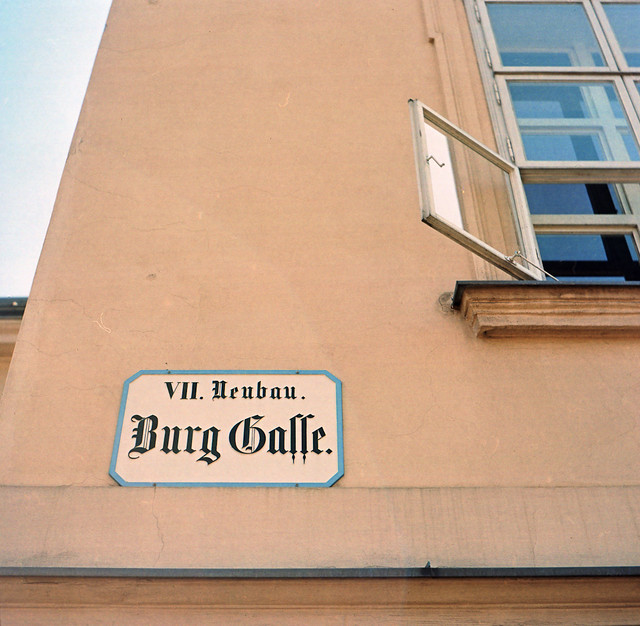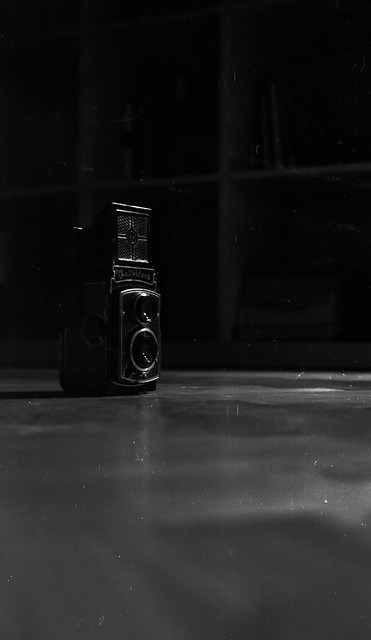Without a doubt, this year's highlight has been the completion of my dearest camera project.
Two years ago, as I was celebrating my second analogversary, I told you about what was to be my most special challenge for the following year: the quest for a camera made in 1912, exactly 100 years before our son was born. Romantic as I am, I wanted to find one that was still able to take photographs.
One year ago, on my third analogversary, I told you about one Vest Pocket Kodak that I found here in Vienna. This camera was a good candidate, since the first production run of the original (non-autographic) model took place from 1912 to 1914. It was in surprisingly good shape, especially for a near 100-year-old camera that has seen two world wars. The camera body, though, was badly deformed and the shutter did not fire at all. I did not really see a way to make it fit for taking pictures. For a couple of months I left the VPK project in standby.

Later this year I found another original Vest Pocket Kodak which turned out to be in much poorer condition, but had a working shutter and an intact camera body. The VPK project was alive again. After some hesitation I contacted Dr. White in the UK, whose website Collecting Vest Pocket Kodak Cameras is one of the best references that I could find about this camera model. I asked him for help in dating both of my VPK cameras. He was kind enough to recognize how meaningful this quest was to me, as he seems to share with me a passion for such endeavors, and promptly helped me with his ample knowledge. After some exciting e-mails he was able to confirm to me that, without a doubt, the first camera that I had, the one with the deformed body, came from the first production run in 1912. Square bellows, no "choke" to limit the maximum aperture and, crucially, no lettering on the front standard and no horizontal bar to help switch the waist level finder from the portrait to the landscape position were the features that pointed it to 1912. Again my deep gratitude to Dr. White for his help and for being such a key part in my 1912 camera quest.
I was very excited by this finding but still was not able to use the camera. I decided to build myself a working camera keeping as many parts of the 1912 one as I could. I exchanged the deformed camera body (in fact it is just the back: everything else, bellows, struts, front standard, shutter and lens completely detach in a block from the camera body) with the healthy one. Then I planned to mount the working shutter and lens onto the 1912 front standard but, in a touch of inspiration (with much trial and error and the minute bending of one crucially actuating lever), I managed to fix the 1912 shutter and to make its leaves open and close again. Which is fortunate, because both 1912 lens and shutter are in an almost pristine condition, contrary to the other one, which clearly shows its age. To sum up, I have now a working 1912 Vest Pocket Kodak with a back that, at the latest, was made in 1913 or 1914. This is not only the oldest but without a doubt the most special and meaningful camera that I own.

(Vest Pocket Kodak, Meniscus Achromat, Efke 100, ISO 100/21°)
It made me especially happy that the first pictures that I took with this camera were those of our son's second birthday, 102 years after the camera was built. After developing the film and looking at the pictures I was truly impressed by the performance of this very simple meniscus lens. The light leaks apparent in both pictures I am posting here are not the camera's fault, but mine: as I took out the exposed roll of film from the camera, the protective paper unrolled a bit and let a little light in. The camera bellows is perfectly light tight.

(Vest Pocket Kodak, Meniscus Achromat, Efke 100, ISO 100/21°)
The 1912 Vest Pocket Kodak is not the most convenient camera to use, but still quite usable and, as its name promises, extremely easy to carry around. I used it again two weeks ago on 2nd Winter 127 Day (127 film was, in fact, introduced in 1912 specifically for this camera model!) and I am taking the 1912 VPK with me again this Christmas.
My plans for the next year are again collect less and shoot more. Well, not only shoot more but shoot better. I want to concentrate on using less cameras, my dearest ones, and try to take the most out of them. In this year I have the feeling I experimented too much: too long expired films, too extreme lighting conditions, too many poorly thought pictures shot hoping that they would come out fine. Most of them didn't. I wish to be able to take a little more time and consciousness in the picture taking act. I know I already have fine cameras and lenses, very capable of delivering quality. The weak link in the chain is now the photographer. I also want to concentrate on less films, the ones that worked best, and try to make the film choice a conscious picture taking decision at the same level as are framing, composition and depth of field.
I want to keep on doing my own repairs. Working on my cameras not only makes me strangely happy but also makes me know them a lot better. I (begin to) deeply understand what happens as I cock the shutter, as I advance film, as I change shutter speeds, inside many of my cameras. And this knowledge is gold for the times when things do not work properly. I really wish I manage to make the shutter in my Contax II work, since I have the gut feeling this camera could be the one to which I will always be returning.
I want to extend my developing skills beyond black and white. I am going to research the feasibility of developing color negative (C-41 process) and/or color slide (E-6 process) film at home, because I keep reading that it is not harder than black and white development. And, yes, I still find this caffenol development thing very exciting... :)
And, of course, I want to find more time to write about my photographic challenges here in my blog. I hope you'll keep on sharing this journey with me! :)








![good luck [stranger 22/99]](https://farm6.staticflickr.com/5607/15744509726_582bd0a1d3_z.jpg)








![sofortdienst [stranger 21/99]](https://farm6.staticflickr.com/5523/12195832966_20baafcbfe_z.jpg)












